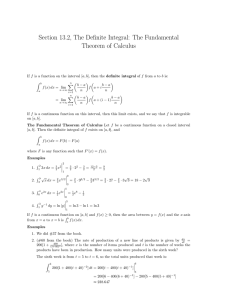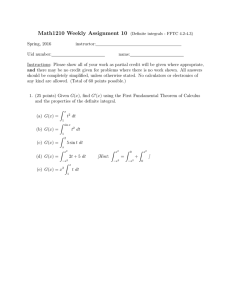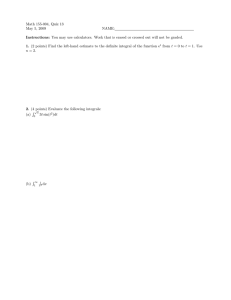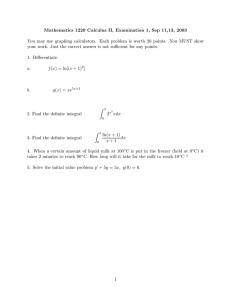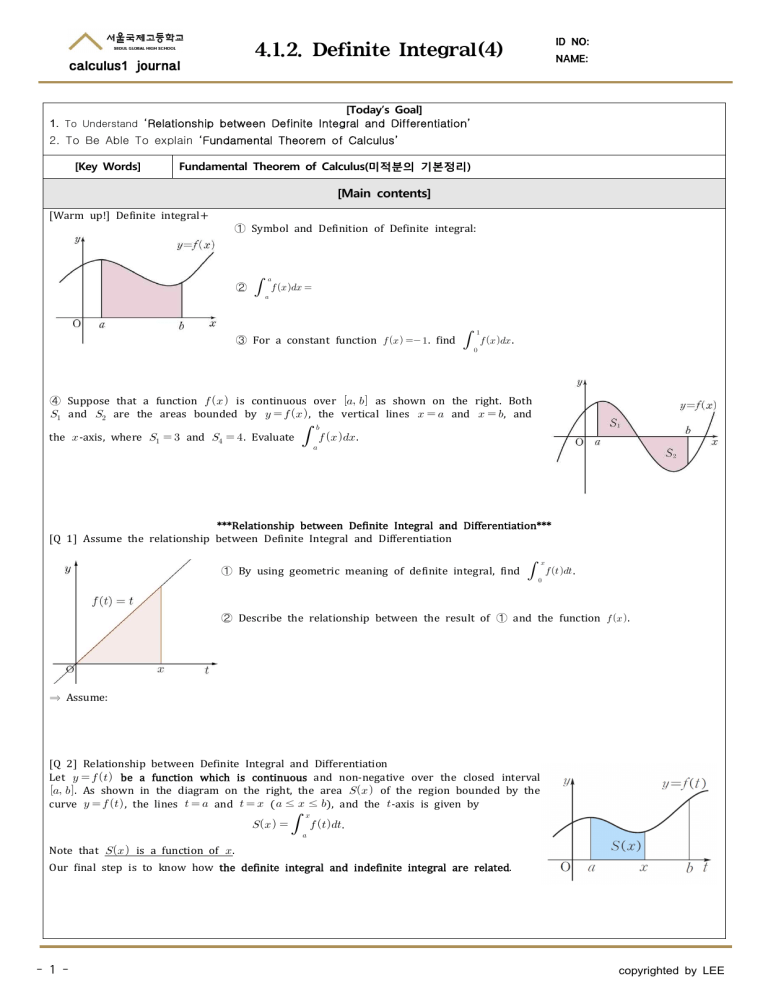
ID NO: 4.1.2. Definite Integral(4) NAME: calculus1 journal [Today’s Goal] 1. To Understand ‘Relationship between Definite Integral and Differentiation’ 2. To Be Able To explain ‘Fundamental Theorem of Calculus’ [Key Words] Fundamental Theorem of Calculus(미적분의 기본정리) [Main contents] [Warm up!] Definite integral+ ➀ Symbol and Definition of Definite integral: ➁ ➂ For a constant function . find . ➃ Suppose that a function is continuous over as shown on the right. Both and are the areas bounded by , the vertical lines and , and the -axis, where and . Evaluate . ***Relationship between Definite Integral and Differentiation*** [Q 1] Assume the relationship between Definite Integral and Differentiation ➀ By using geometric meaning of definite integral, find . ➁ Describe the relationship between the result of ➀ and the function . ⇒ Assume: [Q 2] Relationship between Definite Integral and Differentiation Let be a function which is continuous and non-negative over the closed interval . As shown in the diagram on the right, the area of the region bounded by the curve , the lines and ( ≤ ≤ ), and the -axis is given by . Note that is a function of . Our final step is to know how the definite integral and indefinite integral are related. - 1 - copyrighted by LEE 4.1.2. Definite Integral(4) calculus1 journal ID NO: NAME: To analyze the function , we will observe the derivative ′ . ❶ However, we don't know whether ′ exists or not (we don't know the equation for at the moment). ❷ So, we need to approach the derivative ′ by definition. ❸ By definition, ′ ∆ , where ∆ is small, and the increase in is ∆ : ∆ ∆ . lim ∆ ∆→ Q1. Find the area that represents ∆ on the right. ∆ Q2. What value does approach as ∆→? ∆ [Hint: We can approximate ∆ by applying quadrature by parts. That is, we can approximate ∆ with a rectangle that has width ∆.] ∆ ❹ Prove Q2. Since it is difficult to evaluate ∆ (actually, we can evaluate ∆ by applying quadrature by parts), we will use the Squeeze Theorem. Since is continuous over ∆, it attains both a maximum and a minimum value there. ∆ is a limit, so we should consider both the left-hand limit and the right-hand limit, that is, the lim ∆ (Note that ∆→ limits for ∆ and ∆ .) When ∆ , attains a maximum value and a minimum value over the closed interval ∆. Comparing areas, we have · ∆ ≤ ∆ ≤ · ∆ -----➀ When ∆ , attains a maximum value and a minimum value over the closed interval ∆. Comparing areas, we have · ∆ ≥ ∆ ≥ · ∆ -----➁ ∆ Using ➀ and ➁, we can get the inequality for : ∆ ∆ ≤ ≤ . ∆ Letting ∆→: lim ≤ ∆→ ∆ ≤ lim . lim ∆ ∆→ ∆→ Since is continuous over the closed interval ∆, as ∆→, both → and →. Thus, ≤ ≤ . That is, . ∴ The Relationship Between Integration and Differentiation Given a function which is continuous over a closed interval , ( ≤ ≤ ). [Note: is an antiderivative of .] [Example 1] Evaluate the following: (1) - 2 - (2) copyrighted by LEE 4.1.2. Definite Integral(4) calculus1 journal ID NO: NAME: [Exercise 1] Find the derivatives of the following functions: (1) (2) (3) (4) ***The Fundamental Theorem of Calculus*** Using the relationship between integration and differentiation, we can obtain a relationship between indefinite integrals and definite integrals. The result is called the Fundamental Theorem of Calculus. Given a function which is continuous over a closed interval , let ( ≤ ≤ ). The relationship between integration and differentiation tells us that ′ ≤ ≤ . That is, is an antiderivative of ; thus, if is any antiderivative of , then , for some real number . [Note: Since is a function, is a constant defined by .] Since ____, we have ⇒ , and . Normally, we write this expression without : ---➀ Q1. Using ➀, express in terms of . . The Fundamental Theorem of Calculus If a function is continuous over a closed interval and has an antiderivative , then . [Note: We can denote as .] [Example 2] Evaluate the following definite integrals: (1) - 3 - (2) copyrighted by LEE ID NO: 4.1.2. Definite Integral(4) NAME: calculus1 journal [Q 3] and By using FTC, describe the relationship between and . Properties of Definite Integrals(1) If a function is continuous on a closed interval , then the following properties hold: ❶ ❷ [Exercise 2] Evaluate the following definite integrals: (1) (2) (3) [Exercise 3] p.148 [문제 02], [문제 03], [문제 04] [Exercise 4] p.153 [문제 08] summarize - 4 - copyrighted by LEE
